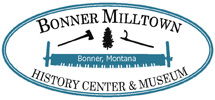 Andrew B. Hammond (1848-1934)Andrew B. Hammond (1848-1934), son a of a lumberman, was born in St. Leonards, New Brunswick. Like many other young men of the time, he eventually moved west. About 1870 Hammond found himself in Missoula, where he obtained a job in a general store, and by 1871 he was working as a salesman for Bonner and Company’s store. By 1877, he became a partner with Richard Eddy and Edward Bonner, in the business which was now called Eddy, Hammond and Company. This eventually became the Missoula Mercantile with Hammond as general manager.
Andrew B. Hammond (1848-1934)Andrew B. Hammond (1848-1934), son a of a lumberman, was born in St. Leonards, New Brunswick. Like many other young men of the time, he eventually moved west. About 1870 Hammond found himself in Missoula, where he obtained a job in a general store, and by 1871 he was working as a salesman for Bonner and Company’s store. By 1877, he became a partner with Richard Eddy and Edward Bonner, in the business which was now called Eddy, Hammond and Company. This eventually became the Missoula Mercantile with Hammond as general manager.
Dale Johnson, retired archivist for the University of Montana, wrote his dissertation on Hammond. According to Johnson, by the 1880s, Hammond owned or otherwise controlled the following:
- Missoula Mercantile (Montana's largest wholesale and retail store)
- Big Blackfoot Milling Co. (the largest mill between Wisconsin and the West Coast)
- Flour mill at Bonner
- Grain elevators in western Montana
- Missoula Real Estate Association (including Florence Hotel, the Hammond Block, and many other downtown blocks)
- First National Bank (western Montana's largest bank)
- South Missoula Land Company (owned residential areas south of the Clark Fork River)
- Missoula Water Works and Milling Company (all water and electricity)
- Missoula Street Railway Company (horse drawn)
- Missoula Publishing Company (Missoulian)
- Missoula Valley Improvement Company (owned the cemetery)
In addition, the partnership created by the formation of the Montana Improvement Company in 1882 took advantage of the huge profits to be made in timber. After obtaining an initial contract from the railroad in 1881, the company built several sawmills around Missoula to supply lumber for ties and timbers for the trestles (Marent Trestle) and tunnels. The three original partners, Eddy, Hammond, and Bonner now joined with M. J. Connell, Marcus Daly, and Washington Dunn of Northern Pacific. With capital of $2 million, over half of which came from Northern Pacific, the corporation was authorized to do business in Montana, Idaho, and Washington. Hammond, became the force behind the group, and took charge of building of the new Blackfoot Mill at Bonner.
Hammond is perhaps better remembered today on the west coast, where he moved in the 1890s after divesting himself of his Missoula holdings. On the coast he amassed huge lumber holdings and created the Hammond Lumber Company as well as several railroad lines. He died in California in 1934.
According to Missoula historian Lenora Koelbel, after Hammond left Missoula Hammond Avenue was renamed as Gerald Avenue (after one of C.P. Higgins children) because of the rift between C. P. Higgins and Hammond. However, the Hammond Arcade, a one-story rebuilding of Hammond’s huge, four-story office building that burned in 1932, still retains his name.
